 Dietary supplement usage is reaching an all-time high. The 2019 Consumer Survey on Dietary Supplements revealed that 77% of Americans consume supplements. This is a dramatic increase from the 53% reported by the NHANES in 2010. Americans are spending $38.8 billion a year on supplements, with more than 85,000 supplements on the market. Reasons for consumption are widespread, ranging from athletes hoping to boost performance to people who need more Vitamin D for bone health.
Dietary supplement usage is reaching an all-time high. The 2019 Consumer Survey on Dietary Supplements revealed that 77% of Americans consume supplements. This is a dramatic increase from the 53% reported by the NHANES in 2010. Americans are spending $38.8 billion a year on supplements, with more than 85,000 supplements on the market. Reasons for consumption are widespread, ranging from athletes hoping to boost performance to people who need more Vitamin D for bone health.
With the rise in supplement usage, it is important to be an informed consumer. While there are numerous reasons for this, one of the biggest is that supplements are loosely regulated by the FDA, meaning labels may not display what is truly in the supplement. Also, claims marketed about the benefits of a supplement may be false because companies are not required to obtain authorization from the FDA prior to making such nutritional support claims.
How can you know whether what you’re taking is safe and effective? Let’s dive in!
What Is a "Dietary Supplement?"
According to the Dietary Supplement Health and Education Act of 1994 (DSHEA), a dietary supplement means “a product (other than tobacco) intended to supplement the diet that bears or contains one or more of the following ingredients:
- Vitamin
- Mineral
- Herb or other botanical
- Amino acid
- A dietary supplement used by man to supplement the diet by increasing dietary intake
- A concentrate, metabolite, constituent, extract, or combination of any ingredient described in the above.”
Are Dietary Supplements Regulated? Can Supplements Be Trusted?
Technically, yes, supplements are regulated by the FDA under the DSHEA. However, there are loopholes to consider:
- The FDA does not inspect products before they are sold, nor do they require registration unless the supplement contains a new ingredient not yet on the market.
- The only formulation standard is the Current Good Manufacturing Practice (GMP); however, 2013 report by the FDA revealed that 70% of inspected manufacturers were in violation of GMPs. Not all products even get inspected after being on the market. The FDA states the manufacturer is responsible for ensuring safety and quality, but clearly some manufacturers are doing a poor job, and the FDA is only catching some.
- Nutrition supplements may not claim to diagnose, cure, prevent, or treat diseases. Sure enough, some manufacturers have managed to ignore this. A 2003 study found that 81% of 338 herbal supplement retail websites made one or more health claims, and 55% claimed to diagnose, cure, prevent, or treat specific diseases.
What Can You Do to Be Safe When Taking Supplements?
Blind trust in supplements is unwarranted; however, there are steps you can take to ensure your safety while taking them.
- Check the label for a stamp indicating third-party verification. Independent third parties are hired by manufacturers to thoroughly test products, ensuring accuracy of ingredients, potency, and amounts; absence of toxic compounds; and production in compliance with FDA GMPs. Credible third parties include NSF International and US Pharmacopeia (USP).
- Athletes: look for the NSF Certified for Sport stamp. The USA Doping Agency (USADA) has recognized this program as best suited to assist athletes in choosing supplements that do not contain banned substances for sports.
- Download the NSF International App. It shows which products are NSF approved—right at your fingertips anytime, anywhere.
- Check out the Dietary Supplement Fact Sheets published by the National Institutes of Health: Office of Dietary Supplements. This government agency has quick fact sheets about a variety of dietary supplements, including vitamins, minerals, probiotics, botanicals and herbs, and more.
Speak with a Registered Dietitian for supplement guidance and which supplements may (or may not) be right for you. NIFS Registered Dietitians are available to help you!
This blog was written by Sabrina Goshen, NIFS Registered Dietitian. To learn more about the NIFS bloggers, click here.


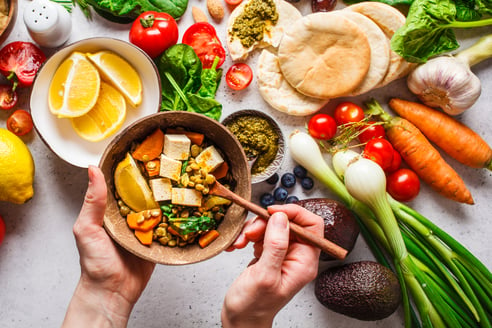 A few years ago, I made it my New Year’s Resolution to completely cut out animal products from my diet. I had played around with a couple variations of diets for a few years in college while competing in a Division 1 rowing program—cutting out all red meat, processed meats, and chicken, and only eating fish. Essentially the only things left were the eggs, milk, and cheese. I had been hesitant because cheese was my absolute favorite thing to add to every meal. I dreamed about doing a cheese and wine tour of Europe one day—I was really in love with cheese.
A few years ago, I made it my New Year’s Resolution to completely cut out animal products from my diet. I had played around with a couple variations of diets for a few years in college while competing in a Division 1 rowing program—cutting out all red meat, processed meats, and chicken, and only eating fish. Essentially the only things left were the eggs, milk, and cheese. I had been hesitant because cheese was my absolute favorite thing to add to every meal. I dreamed about doing a cheese and wine tour of Europe one day—I was really in love with cheese. These past few weeks have been trying times for not only our families and friends, but also for the athletes we engage with on a daily basis throughout the year. In our position we must stay in a lead-by-example mentality. If we let ourselves go during this time, our athletes will notice and do the exact same thing. This is definitely a time of uncertainty and there are a lot of unknowns. Controlling what we can control on a daily basis is what will help not just us personally, but also those around us, to get through and come out of this on top.
These past few weeks have been trying times for not only our families and friends, but also for the athletes we engage with on a daily basis throughout the year. In our position we must stay in a lead-by-example mentality. If we let ourselves go during this time, our athletes will notice and do the exact same thing. This is definitely a time of uncertainty and there are a lot of unknowns. Controlling what we can control on a daily basis is what will help not just us personally, but also those around us, to get through and come out of this on top.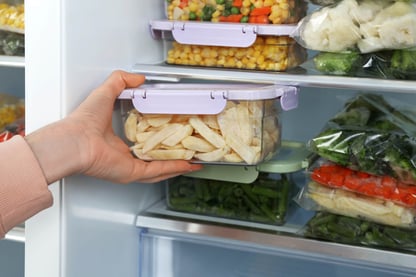 When I say “meal prep,” do you picture hours upon hours in the kitchen, a stockpile of containers, and food that you are sick of by week’s end? PAUSE right there! I am here to tell you that meal prep does not have to be that way. It does not have to be too time-consuming or hard, and you don’t have to eat the exact same meal over and over.
When I say “meal prep,” do you picture hours upon hours in the kitchen, a stockpile of containers, and food that you are sick of by week’s end? PAUSE right there! I am here to tell you that meal prep does not have to be that way. It does not have to be too time-consuming or hard, and you don’t have to eat the exact same meal over and over.  Can we just cut out the term “cheat meal” already? This fuels the idea that foods are “good” or “bad,” and, in turn, our food choices then become this reflection of us, as humans, being “good” or “bad.” News flash, you are not “bad” for eating a specific food.
Can we just cut out the term “cheat meal” already? This fuels the idea that foods are “good” or “bad,” and, in turn, our food choices then become this reflection of us, as humans, being “good” or “bad.” News flash, you are not “bad” for eating a specific food. Take these next few weeks or so and use them to your advantage. We know this is an extremely challenging time, and we want to make sure you feel like you are taken care of. Circumstances are tricky right now, so even if you adopt one new technique, consider that a win! Don’t expect yourself to “eat the rainbow” every day, feel like you fall asleep easily at night from a relaxing day working at home in your pajamas, or get in a 10-mile run each morning. While you shelter at home and stay healthy, keep these tips in mind.
Take these next few weeks or so and use them to your advantage. We know this is an extremely challenging time, and we want to make sure you feel like you are taken care of. Circumstances are tricky right now, so even if you adopt one new technique, consider that a win! Don’t expect yourself to “eat the rainbow” every day, feel like you fall asleep easily at night from a relaxing day working at home in your pajamas, or get in a 10-mile run each morning. While you shelter at home and stay healthy, keep these tips in mind..jpg?width=404&name=GettyImages-980276548(1).jpg)
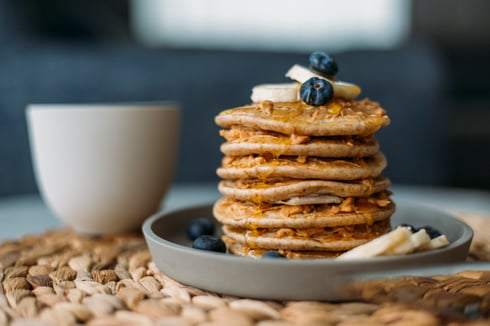 Ingredients
Ingredients The kids and grandkids are home! With them being home, this means you are having to provide breakfasts and lunches. For those that relied on schools to provide these meals, this can be a stressor added to the day. Maybe your kids received meals for free or at a reduced price. Maybe you are being expected to work from home, all while attempting to help your kids through e-learning and cook them lunch. There are an abundance of reasons as to why this may be tough. You are not alone. We are in this together- as a community. We will get through this.
The kids and grandkids are home! With them being home, this means you are having to provide breakfasts and lunches. For those that relied on schools to provide these meals, this can be a stressor added to the day. Maybe your kids received meals for free or at a reduced price. Maybe you are being expected to work from home, all while attempting to help your kids through e-learning and cook them lunch. There are an abundance of reasons as to why this may be tough. You are not alone. We are in this together- as a community. We will get through this.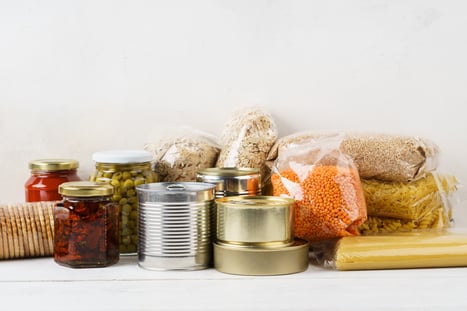 1. Stock up on nutritious foods from all food groups.
1. Stock up on nutritious foods from all food groups. 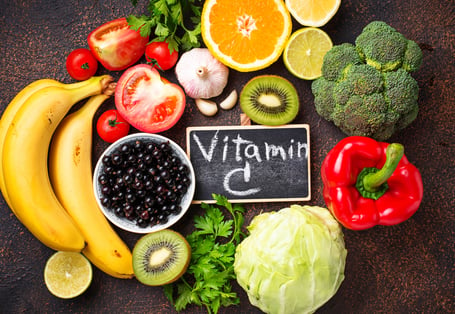 During cold and flu season, we try to do all we can to prevent illness or speed up how fast we recover from illness. One such strategy many employ is the use of Vitamin C for a natural remedy. Several products are marketed as immune system boosters because they contain large amounts of Vitamin C. Do these products really work? We set out to investigate!
During cold and flu season, we try to do all we can to prevent illness or speed up how fast we recover from illness. One such strategy many employ is the use of Vitamin C for a natural remedy. Several products are marketed as immune system boosters because they contain large amounts of Vitamin C. Do these products really work? We set out to investigate!